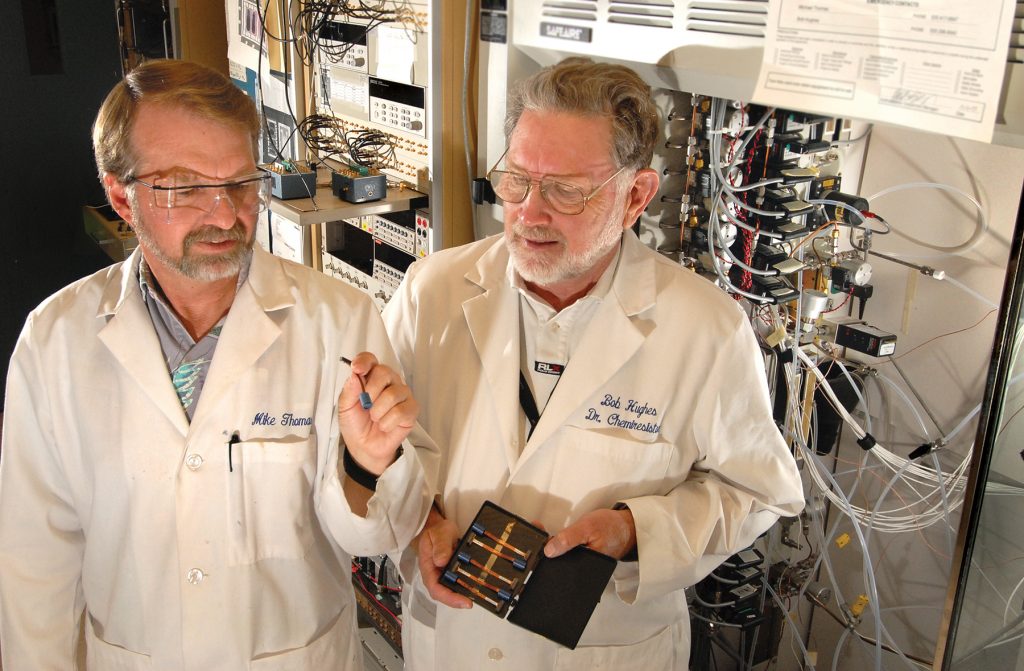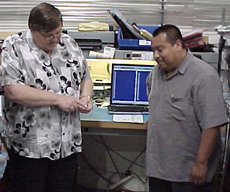
ALBUQUERQUE, N.M. —After more than a decade of research and development, a hydrogen sensor invented by researchers at Sandia National Laboratories is soon to find its way into petroleum refining, hydrogen production, chemical industries, chlorine production, nuclear waste monitoring and fuel cells.
The sensor, named by Sandia the Wide-Range Hydrogen Sensor, followed an unusual technology transfer path that in 2006 won it the coveted Federal Laboratory Consortium (FLC) Award for Excellence in Technology Transfer. The technology has been successfully commercialized by the Valencia, Calif.-based company H2scan through a license agreement and a cooperative research and development agreement (CRADA).
Retired Sandia researcher Bob Hughes led design efforts of the sensor — the only one of its kind to offer both low-range and high-range real-time hydrogen measurement capability on the same chip. It virtually eliminates false readings and extends the time between calibration, making the sensor an ideal candidate for a variety of government and commercial applications.
“The sensor is unique because it was the first to put a field effect transistor (FET) and a resistor on the same pencil eraser-size chip,” says Hughes. “The combination of the two gives it the ability to sense a range of hydrogen concentrations — from large amounts down to parts per million.”
Sandia is a National Nuclear Security Administration laboratory.
Tech transfer path
A patent on the device was awarded in 1994. Two years later the technology was licensed to a company called DCH Technology, which learned about the Robust Hydrogen Sensor after it won a 1993 R&D 100 award as one of the best inventions of the year. Company officials wanted to use the technology for commercial applications.
The device — as new, exciting, and functional as it was — had a problem. When exposed to some corrosive gases, the sensor stopped working, rendering the technology useless for those applications.
After four years of work and an investment of about $7 million, DCH Technologies could not resolve that issue, among other problems. It suffered financial difficulties and in 2002 sold its assets to H2scan, headed by former DCH consultant Dennis Reid.
The license reverted back to Sandia. Labs officials were concerned that the new company would have the same problems as DCH and wanted to prevent failure.
“This is where it gets interesting and Sandia’s creativity kicks in,” says Paul Smith, Sandia licensing executive. “We thought that if Sandia researchers could help the company with the science, there could be a breakthrough that would resolve the corrosive gas issue.”

(Media are welcome to download/publish this image with related news stories however no high-resolution images are available).
Unusual CRADA
In an unprecedented move, Sandia and H2scan signed a CRADA in which the license agreement and CRADA are linked so that some payments under the license agreement are forgiven as long as there is a continuing collaboration under the CRADA. H2scan provides the “funds-in” for the CRADA that began in 2003.
Hughes was lured back from retirement to act as a consultant on the CRADA and advise H2scan on fabrication and testing issues for a new Wide Range version of the Robust Hydrogen Sensor. Unlike the Robust Hydrogen Sensor, the Wide Range Sensor uses a capacitor and resistor on the same chip to achieve a measurement range of 15 parts per million (ppm) to 100 percent by volume. H2scan undertook the difficult task of fabricating the Wide Range Sensor using a number of suppliers and in-house facilities. It also completely redesigned the electronics and packaging for the complete sensor system.
Success
In a little over a year and with an investment of more than $1 million, H2scan had its first retail product and a handheld hydrogen leak detector capable of detecting high and low hydrogen concentrations.
In 2005 H2scan hired a PhD consultant with more than 10 years of experience at Intel to lead the sensor design process. During the next two-and-a-half years the company developed a proprietary coating over the sensor die that can withstand harsh gases such as carbon monoxide, hydrogen sulfide and condensed water. H2scan also came up with an advanced manufacturing process that reduced completion time to make a full wafer set from three-and-half months to three-and-a-half days.
“We now can make 7,000 sensors every three-and-a-half days and deploy our sensor in line real time in the presence of carbon monoxide, hydrogen sulfide, and chlorine,” Reid says. “That is true success considering where we started in 2002.”
Sandia collaboration essential
Reid says that the partnership between his company and Sandia is what led to the fast commercialization of the sensor.
“Our success in providing commercialized products is linked directly to our close working relationship with Sandia,” he says. “The CRADA gave us the opportunity to capitalize on Sandia’s long history with the sensor technology, primarily in the area of process development, resulting in an extremely fast turnaround time for product development.”
Without the ability to have daily interactions with the technology’s creator and the use of Sandia’s environmental testing capability, Reid says, the sensor would have had a longer, more expensive road to commercialization, and the company’s ability to survive through the development stage would have been jeopardized. The CRADA also opened the door for future collaborations between H2scan and Sandia, says Reid.
Today, the CRADA continues. Sandia’s role is to periodically test H2scan sensors in its Gas Sensor Test Bed. The facility enables testing of multiple hydrogen sensors in a wide variety of conditions not available elsewhere.
H2scan has three product lines — portable leak detectors, fixed mounted area monitors, and in-line real-time process monitors. It has delivered sensors to more than 200 government and industry customers, including a classified DOE plant in Idaho Falls, numerous oil companies, Air Products, PraxAir, Air Liquide, UOP, Total, General Electric, Boeing, Bechtel, NASA, Lockheed Martin, Merck, Nissan, Toyota, GM, Honda, Ballard, UTC, Northrop Grumman, Shell Hydrogen, Ball Aerospace, Westinghouse, and others. Reid expects to release the product soon for refineries and is working closely with one of the world’s largest providers of systems for refiners worldwide.
